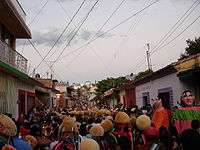Parachico

The Parachico or Parachicos are traditional dancers from Chiapa de Corzo, Chiapas, Mexico, who dance on the streets of the town during the Great Feast festivity, which takes place from January 15 to 23 every year. The festivity takes place in honor of the local patron saints Our Lord of Esquipulas, Saint Anthony Abbot and Saint Sebastian.It is claimed locally, as many of the Catholic festivals are, in Latin America, to have its roots in the much older indigenous culture. So it has developed into a hybrid of old indigenous culture and newer Catholic and Spanish cultures. The church where the festival concludes is home to an old tree, which is said to represent the "tree of life" (drawing on Maya and other pre-Hispanic American cultures), which is claimed locally to predate the church, which would suggest that this site was used for ceremonies before the arrival of Catholicism. Honouring the mother of the cured boy (for the feast) is also locally explained, why on certain nights during the festival, the town's men dress as women and parade through the streets.
The festivities, which include Roman Catholic religious ceremonies, music, dancing and local cuisine, have been included in UNESCO's Intangible Cultural Heritage Lists on November 16, 2010, listed as "Parachicos in the traditional January feast of Chiapa de Corzo".[1]
History

It has pre hispanic origins, however, the traditional dates back to the seventeenth century with the arrival of the image of San Sebastian Martyr to the then Royal Villa Chiapa or Chiapa of the indians and the building of the temple, completed in the seventeenth century. There are many versions of the history of parachico but all agree to the myth that one day a beautiful woman seeking a cure for her sick son but after visiting doctor and healers, failed to alleviate it. Someone told her to go Chiapas where surely find the cure, then she moved with all it's servants.
She wanted to consult a famous indian healer and went to visit him: "Make way going to spend my lady Maria de Angulo" shouted the servants. The healer recommended to the spanish rich take her sick child to the healing waters of cumbujuyú and bathe him for nine days. This done, the child was healed and in gratitude Maria de Angulo gave food and groceries, while the costumed servants danced to entertain children. Others attribute from the name "para chico", translated to for (the) boy.
Attire
Parachicos wear wooden masks with Caucasian features, such as light skin, facial hair and blue eyes, in contrast to Native people's features. They also wear a round headdress, colorful ribbons, striped serapes, embroidered shawls, usually over black or dark shirt and trousers. Parachicos use metallic rattles locally known as chinchin or chinchines, with colorful ribbons attached to the top and/or handles, which are shaken as they dance and chant.
Declaration as Intangible Cultural Heritage

On November 16, 2010, the act of parachicos was declared Intangible Cultural Heritage by UNESCO. The decision was adopted at the meeting of the Intergovernmental Committee for the Safeguarding of the Intangible Cultural Heritage, held in Nairobi, Kenya, under the name "Parachicos in the traditional January feast of Chiapa de Corzo
See also
References
- ↑ "Parachicos in the traditional January feast of Chiapa de Corzo". UNESCO Culture Sector. Retrieved 2011-02-03.
External links
- Parachico Mask Carver - masksoftheworld.com
- Parachico in Chiapa de Corzo - concierge.com
- Chiapa de Corzo, Fiesta of San Sebastian, Parachico Dancers - web.mac.com